”But Turner—especially in his own last years—was not at all hostile to the incoming empire of technology. Quite the opposite: he believed that the speeding train or the chugging paddle steamer could be turned into a visual lyric that married time with motion. For that matter, since the two vessels are sailing upstream, and thus westward, the vermillion sky behind them, in the east, may actually be a sun rise, a fanfare for the future, not a dirge for the past. That’s the wonderful thing about being British: you can never really tell which is which.” ( Simon Schama )
Turner seems, indeed, to have taken to drink, but only at the very end. The years after 1840 produced some of his consummate expressions, although toward the last, he became, for the first time in his fifty years as a prominent artist, dull and heavy handed. He exhibited four pictures at the Academy the year before he died, and even in the year of his death he managed to attend the varnishing days, the occasions when, often, he had completed his canvases as they were being hung on the wall.
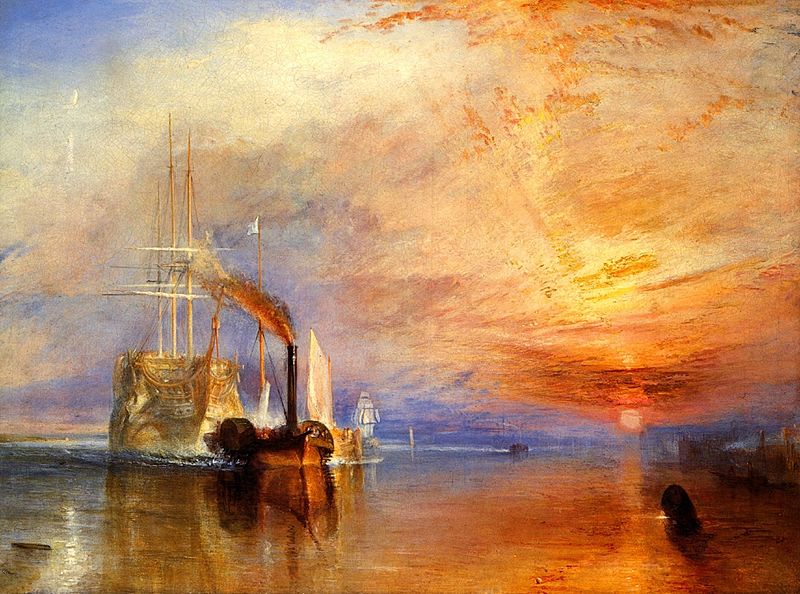
Schama: ''In the century and a half since Turner was buried, in St. Paul's Cathedral, the British have loved him with a grateful ardor that has nothing to do with his place in the genealogy of modernism and everything to do with the poetic visualization of their history. The year before last, BBC's Radio 4 asked listeners to vote for the greatest painting—from anywhere in the world, any time. The hot candidate was, unsurprisingly, Constable's "Haywain," that cart-horse idyll by a plashy stream that seems to preserve the English countryside, in all its cow-parsley, humming-bee, "Wind in the Willows" summery splendor forever and ever amen. But the winner was Turner's "The Fighting Temeraire Tugged to Her Last Berth to Be Broken Up" (1838), a painting not about the embalming of the British past but about its unsentimental coupling with the future. ''
His last works seemed to reinforce and expose Turner’s capacity to be monotonous in the absence of any inspiration leaving an impression of general ambivalence as if the genre had reached a wall, and was incapable of reinvention.To be sure, Turner was a great artist-an artistic pioneer whose focus on light prefigured the Impressionists, and whose feel for evocative atmospheres and the drama of the natural elements was unsurpassed. While such qualities made him unique, however, they also contributed to a sense of one-dimensionality, almost formulaic like serial novels. The imagery changes but the feeling left behind is the same.
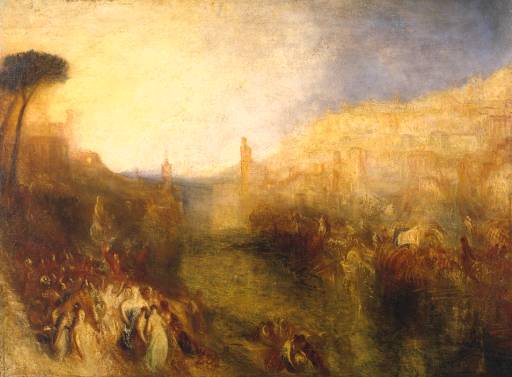
Tate:''Turner's last appearance at the annual Royal Academy exhibitions was in 1850, when he showed four pictures of the story of Dido and Aeneas. This is the concluding scene, which shows Dido and her attendants watching Aeneas as he leaves Carthage for Italy. Aeneas had been told that it was his destiny to become the founder of Rome, but his love for Dido had tempted him to stay in Carthage and put off his final journey to Italy. After his departure the heartbroken Dido killed herself. When Turner had shown this painting in the Royal Academy he had printed lines from his poem The Fallacies of Hope in the catalogue; but a reviewer writing in the Spectator said that the only fallacy was there being 'any hope of understanding what the picture means.''
Turner left an estate of 140,000 pounds which would be perhaps a billion dollars today in market value for his work. During his life he had never given much sign of interest in the artists position in society, but he left funds to establish a foundation that would care for indigent artists. It died in the courts, but his daughters, after some legal complications, fared well. He was buried in Saint Paul’s.
One of the few critics who had any idea what Turner was about during his lifetime was John Ruskin, who was forty-four years younger and whose major book, ”Modern Painters” was initiated in 1843 as a defense of Turner. But modern critics have more than made up the difference by a tendency to exaggerate his modernism. Perhaps that is not quite the right way to put it; the modernist tends to concentrate his attention on Turner’s innovations while ignoring the expressive end that those innovations served.
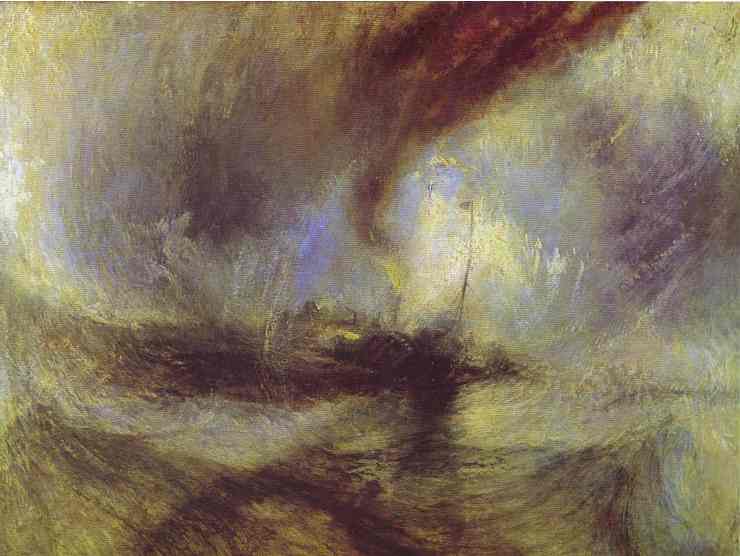
Snow Storm. 1842. tate: ''The steam-boat at the heart of the vortex in this paintings seems to symbolise mankind's futile efforts to combat the forces of nature. The lengthy title provides an elaborate description of exactly what the paddle steamer was doing in such terrible weather conditions; it also includes a personal anecdote claiming that Turner actually witnessed the storm. Later, Turner claimed to a friend that he had been tied to the mast of a ship in order to experience the drama, and had not expected to survive. In fact, this story, and its location in Harwich, were probably invented, but the painting itself is still a strikingly convincing evocation of a storm at sea, the result of a lifetime's experience on Turner's part.''
As a proto-impressionist Turner worked with gobbets of color, but held to no theories of broken color and in his view of the world was as far as possible from the impressionists. Turner’s goal was always epic, never intimate. He was interested in Goethe’s color theories, and worked out charts to analyze them, but in the end it was Goethe’s ideas on the emotional associations of colors and not their physical characteristics that affected him.
Turner,s closest connection with what would be the impressionist technical revolution was his method of creating luminous effects by painting entirely in light tones rather than contrasts of deep shadow and bright color. He thus identified light with pigment, the most generalized statement of the impressionists’ technique; but whether he wax or was not a major influence on Monet, who saw Turner’s in London in 1870, is a question that has two answers, depending usually, on whether you are reading a French art historian or an English one.
Turner’s approach was empirical no matter what his preliminary theories. The diarist Joseph Farington was saying something of the kind when he wrote that Turner ” has no settled process but drives the color until he has expressed the idea in his mind”. Turner probably would not have put it that way himself, but the business of ”driving the color about” has been quoted to establish him as a distinguished grandparent of
ract expressionism, particularly the branch of it called ”action painting” .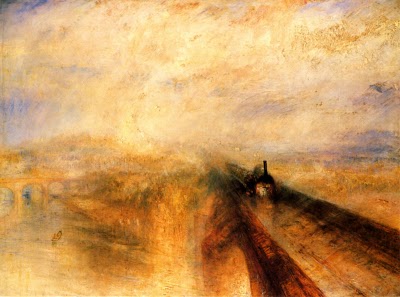
''When Annie and I went to London, I had to see the Turner Gallery at the Tate Britain and the great Turners at the National Gallery, London, including Rain, Steam and Speed—The Great Western Railway (above, from 1844). It took some painful prioritizing, particularly in giving little time to the great William Hogarth collection at the NG, but I managed to see the Turners the way he wished them to be seen, in situ at the museums he imagined them displayed in after his death. No other artist bequeathed such a mother load of art on his country as Turner did after his death. ''
There is a healthy germ of a relationship here. The late Turner painting of storms, where the paint swirls in a great vortex, need only the slightest push to become totally abstract instead of abstractions based on nature, in which the elements are still discernible in their cosmic majesty. The recognition of subject, however, makes all the difference and Turner never crossed that line. ”The works of Pollock, Louis, Noland,and Olitski, wrote Stanley Cavell at the end of the 1960’s, ”achieve in unforeseen paths an old wish of romanticism- to imitate not the look of nature, but its conditions, the possibility of knowing nature at all and of locating ourselves in a world.” The analysis is a bit disingenuous since artists like Pollock were influenced by Jung and Freudian psychology and their point of departure was the intimate and deeply personal.
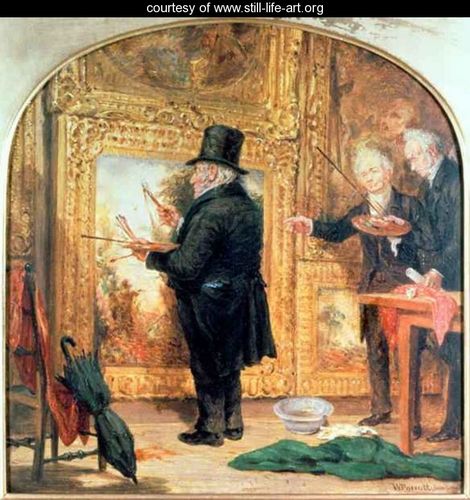
Varnishing day at the Royal Academy was the occasion when an artist was allowed to put final touches on his paintings before exhibition. Turner, shown in this 1846 cartoon by William Parrott, sometimes used the opportunity to paint much of a picture.
At his most abstract, Turner is still employing abstracted pattern and abstracted color as a means to a specific and defined expressive end. He is not dealing with an aesthetic problem in which the means become the end in themselves; which is the exciting convenience, and to some the great tragedy, of contemporary art.
”Aside from the great art itself, I find Turner fascinating for his amazing confidence. He was good, and he knew it well. Everyone else did, too, or they soon did. During the annual exhibition of the Royal Academy, Turner would make a grand show of “Varnishing Day,” a day shortly before the opening of the exhibition to the public and the judges during which artists could varnish or touch up their works. While nearby artists would add a little shimmer to their works, Turner would come in and virtually repaint his works on the spot, adding brilliant color that would outshine the works hung nearby and totally demoralize his fellow painters. One year, John Constable stood nearby and added a little color to some flags in a painting as Turner stood behind him, silently watching. The next day, Turner painted a brilliant red buoy on a seascape that blew Constable’s coloring away, packed up his brushes, and left without a word. “He has been here,” Constable said, “and fired a gun.” When it came to dueling, nobody got the best of Turner.”


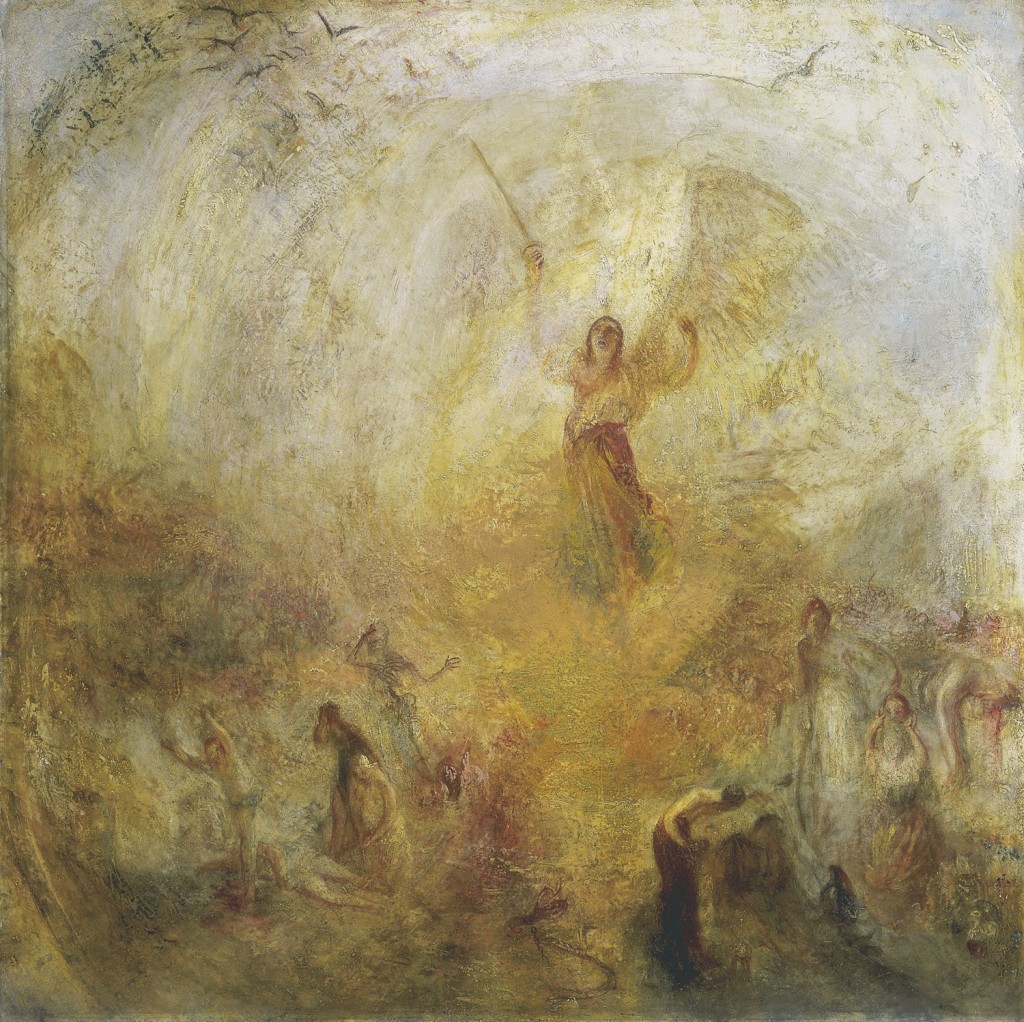



 COMMENTS
COMMENTS